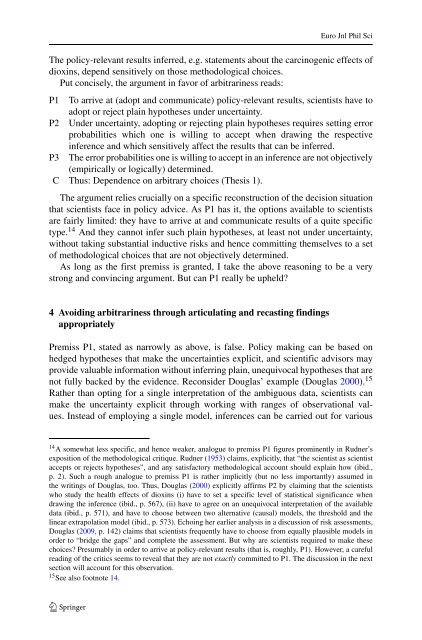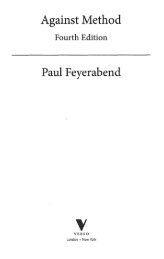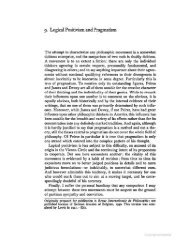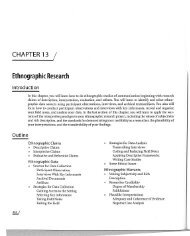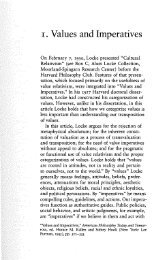EuroJnlPhilSciThe policy-relevant results inferred, e.g. statements about <strong>the</strong> carcinogenic effects <strong>of</strong>dioxins, depend sensitively on those methodological choices.Put concisely, <strong>the</strong> argument in favor <strong>of</strong> arbitrariness reads:P1 To arrive at (adopt and communicate) policy-relevant results, scientists have toadopt or reject plain hypo<strong>the</strong>ses under uncertainty.P2 Under uncertainty, adopting or rejecting plain hypo<strong>the</strong>ses requires setting errorprobabilities which one is willing to accept when drawing <strong>the</strong> respectiveinference and which sensitively affect <strong>the</strong> results that can be inferred.P3 The error probabilities one is willing to accept in an inference are not objectively(empirically or logically) determined.C Thus: Dependence on arbitrary choices (Thesis 1).The argument relies crucially on a specific reconstruction <strong>of</strong> <strong>the</strong> decision situationthat scientists face in policy advice. As P1 has it, <strong>the</strong> options available to scientistsare fairly limited: <strong>the</strong>y have to arrive at and communicate results <strong>of</strong> a quite specifictype. 14 And <strong>the</strong>y cannot infer such plain hypo<strong>the</strong>ses, at least not under uncertainty,without taking substantial inductive risks and hence committing <strong>the</strong>mselves to a set<strong>of</strong> methodological choices that are not objectively determined.As long as <strong>the</strong> first premiss is granted, I take <strong>the</strong> above reasoning to be a verystrong and convincing argument. But can P1 really be upheld?4 Avoiding arbitrariness through articulating and recasting findingsappropriatelyPremiss P1, stated as narrowly as above, is false. Policy making can be based onhedged hypo<strong>the</strong>ses that make <strong>the</strong> uncertainties explicit, and scientific advisors mayprovide valuable information without inferring plain, unequivocal hypo<strong>the</strong>ses that arenot fully backed by <strong>the</strong> evidence. Reconsider Douglas’ example (Douglas 2000). 15Ra<strong>the</strong>r than opting for a single interpretation <strong>of</strong> <strong>the</strong> ambiguous data, scientists canmake <strong>the</strong> uncertainty explicit through working with ranges <strong>of</strong> observational <strong>value</strong>s.<strong>In</strong>stead <strong>of</strong> employing a single model, inferences can be carried out for various14 A somewhat less specific, and hence weaker, analogue to premiss P1 figures prominently in Rudner’sexposition <strong>of</strong> <strong>the</strong> methodological critique. Rudner (1953) claims, explicitly, that “<strong>the</strong> scientist as scientistaccepts or rejects hypo<strong>the</strong>ses”, and any satisfactory methodological account should explain how (ibid.,p. 2). Such a rough analogue to premiss P1 is ra<strong>the</strong>r implicitly (but no less importantly) assumed in<strong>the</strong> writings <strong>of</strong> Douglas, too. Thus, Douglas (2000) explicitly affirms P2 by claiming that <strong>the</strong> scientistswho study <strong>the</strong> health effects <strong>of</strong> dioxins (i) have to set a specific level <strong>of</strong> statistical significance whendrawing <strong>the</strong> inference (ibid., p. 567), (ii) have to agree on an unequivocal interpretation <strong>of</strong> <strong>the</strong> availabledata (ibid., p. 571), and have to choose between two alternative (causal) models, <strong>the</strong> threshold and <strong>the</strong>linear extrapolation model (ibid., p. 573). Echoing her earlier analysis in a discussion <strong>of</strong> risk assessments,Douglas (2009, p. 142) claims that scientists frequently have to choose from equally plausible models inorder to “bridge <strong>the</strong> gaps” and complete <strong>the</strong> assessment. But why are scientists required to make <strong>the</strong>sechoices? Presumably in order to arrive at policy-relevant results (that is, roughly, P1). However, a carefulreading <strong>of</strong> <strong>the</strong> critics seems to reveal that <strong>the</strong>y are not exactly committed to P1. The discussion in <strong>the</strong> nextsection will account for this observation.15 See also footnote 14.
Euro Jnl Phil Scialternative models. Ra<strong>the</strong>r than committing oneself to a single level <strong>of</strong> statisticalsignificance, one may systematically vary this parameter, too. Acting as policyadvisors, <strong>the</strong> scientists can communicate <strong>the</strong> results <strong>of</strong> such a (methodological) sensitivityanalysis. The reported range <strong>of</strong> possibilities may <strong>the</strong>n inform a decision underuncertainty. 16Reporting ranges <strong>of</strong> possibility is just one way <strong>of</strong> avoiding plain hypo<strong>the</strong>ses andrecasting scientific results in situations <strong>of</strong> uncertainty. Scientists could equally inferand communicate o<strong>the</strong>r types <strong>of</strong> hedged hypo<strong>the</strong>ses that factor in <strong>the</strong> current level<strong>of</strong> understanding. They might make use <strong>of</strong> various epistemic modalities (e.g. it isunlikely/itispossible/itisplausible/etc.that...)orsimplyconditionalize on unwarrantedassumptions (e.g. if we deem <strong>the</strong>se error probabilities acceptable, <strong>the</strong>n ...,basedonsuch-and-suchascheme<strong>of</strong>probative<strong>value</strong>s,wefindthat...,giventhatset<strong>of</strong> normative, non-epistemic assumptions, <strong>the</strong> following policy measure is advisable...). 17<strong>In</strong> sum, scientists as policy advisors are far from being required to accept or refuteplain hypo<strong>the</strong>ses. 18 With its original premiss in tatters, <strong>the</strong> above reconstruction <strong>of</strong><strong>the</strong> methodological critique is in need <strong>of</strong> repair. But, in fact, premiss P1 can be easilyamended to yield a much more plausible statement. 19P1’ To arrive at (adopt and communicate) policy-relevant results, scientists have toadopt or reject plain or hedged hypo<strong>the</strong>ses under uncertainty.For <strong>the</strong> sake <strong>of</strong> validity, we have to modify premiss P2 correspondingly.16 <strong>In</strong> <strong>the</strong> sense <strong>of</strong> Knight (1921).17 Curiously, conditionalizing on normative assumptions is exactly <strong>the</strong> strategy favored by Douglas (2009,p. 153), herself. It should be noted that such conditional scientific results comply with <strong>the</strong> <strong>value</strong> <strong>free</strong><strong>ideal</strong>, because once uncertain or (non-epistemic) normative assumptions are placed in <strong>the</strong> antecedent <strong>of</strong> ahypo<strong>the</strong>sis, <strong>the</strong>y are clearly not maintained by <strong>the</strong> scientist anymore.18 This is <strong>the</strong> bottom line <strong>of</strong> Jeffrey’s criticism (Jeffrey 1956), too. However, my argument deviates substantiallyfrom Jeffrey’s in allowing that uncertainties be made explicit o<strong>the</strong>rwise than through probabilityassignments. More generally, it seems to me a shortcoming <strong>of</strong> <strong>the</strong> current debate about <strong>value</strong> <strong>free</strong>dom thatuncertainty articulation is, short-sightedly, identified with <strong>the</strong> assignment <strong>of</strong> probabilities. Not only doesDouglas ignore non-probabilistic uncertainty statements, as I will argue below, Winsberg (2010, pp. 96,119), Biddle and Winsberg (2010) and Kitcher (2011, p. 34), too, wrongly assume that giving <strong>value</strong> <strong>free</strong>policy advice requires one to make uncertainties explicit through probabilities.As an additional point, note that reporting hedged hypo<strong>the</strong>ses is not identical with merely stating <strong>the</strong>(e.g., limited, partially conflicting) evidence and letting <strong>the</strong> policy makers decide on whe<strong>the</strong>r <strong>the</strong> plainhypo<strong>the</strong>sis should be adopted or not. That’s, however, what Elliott (2011) seemstohaveinmindwhenreferring to <strong>value</strong>-<strong>free</strong> scientific advice in <strong>the</strong> face <strong>of</strong> uncertainty, as formulations like scientists “passing<strong>the</strong> buck” (ibid., pp. 55, 64), “withholding <strong>the</strong>ir judgment or providing uninterpreted data to decisionmakers” (ibid., p. 55), letting “<strong>the</strong> users <strong>of</strong> information decide whe<strong>the</strong>r or not to accept <strong>the</strong> hypo<strong>the</strong>ses”(ibid., p. 67) suggest. The point about making uncertainties fully explicit and reporting hedged hypo<strong>the</strong>sesis (i) to enable policy makers to take <strong>the</strong> actual scientific uncertainty into account and (ii) to allow <strong>the</strong>irnormative risk preferences (level <strong>of</strong> risk aversion) to bear on <strong>the</strong> decision. Justifying decisions underuncertainty does obviously not require one to fully adopt an uncertain prediction or to act as if one <strong>of</strong> <strong>the</strong>uncertain forecasts were true; see also footnotes 20 and 21.19 Besides systematic objections, <strong>the</strong> following modification also addresses <strong>the</strong> hermeneutic issue consideredin footnote 14.


